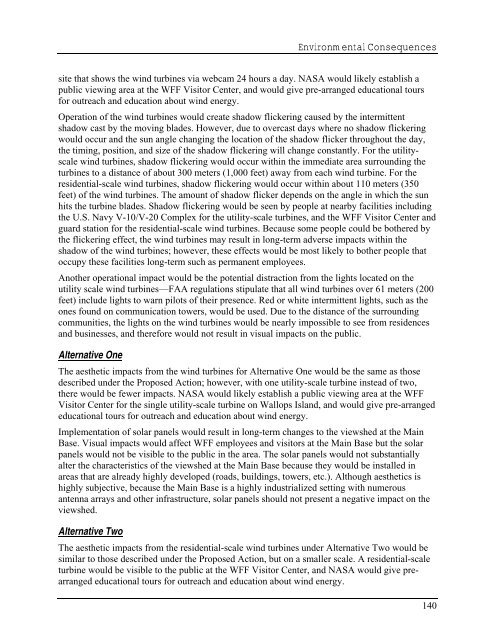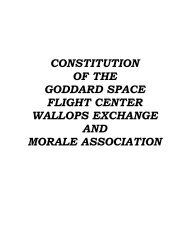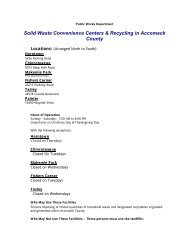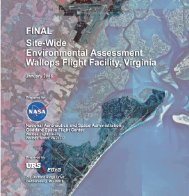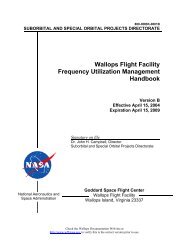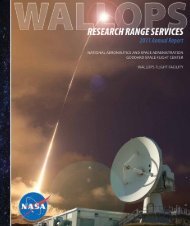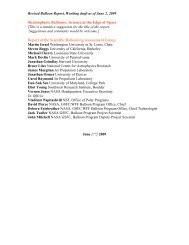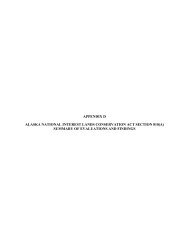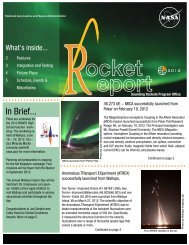Alternative Energy Draft EA - NASA Visitor Center at Wallops Flight ...
Alternative Energy Draft EA - NASA Visitor Center at Wallops Flight ...
Alternative Energy Draft EA - NASA Visitor Center at Wallops Flight ...
Create successful ePaper yourself
Turn your PDF publications into a flip-book with our unique Google optimized e-Paper software.
Environmental Consequences<br />
site th<strong>at</strong> shows the wind turbines via webcam 24 hours a day. <strong>NASA</strong> would likely establish a<br />
public viewing area <strong>at</strong> the WFF <strong>Visitor</strong> <strong>Center</strong>, and would give pre-arranged educ<strong>at</strong>ional tours<br />
for outreach and educ<strong>at</strong>ion about wind energy.<br />
Oper<strong>at</strong>ion of the wind turbines would cre<strong>at</strong>e shadow flickering caused by the intermittent<br />
shadow cast by the moving blades. However, due to overcast days where no shadow flickering<br />
would occur and the sun angle changing the loc<strong>at</strong>ion of the shadow flicker throughout the day,<br />
the timing, position, and size of the shadow flickering will change constantly. For the utilityscale<br />
wind turbines, shadow flickering would occur within the immedi<strong>at</strong>e area surrounding the<br />
turbines to a distance of about 300 meters (1,000 feet) away from each wind turbine. For the<br />
residential-scale wind turbines, shadow flickering would occur within about 110 meters (350<br />
feet) of the wind turbines. The amount of shadow flicker depends on the angle in which the sun<br />
hits the turbine blades. Shadow flickering would be seen by people <strong>at</strong> nearby facilities including<br />
the U.S. Navy V-10/V-20 Complex for the utility-scale turbines, and the WFF <strong>Visitor</strong> <strong>Center</strong> and<br />
guard st<strong>at</strong>ion for the residential-scale wind turbines. Because some people could be bothered by<br />
the flickering effect, the wind turbines may result in long-term adverse impacts within the<br />
shadow of the wind turbines; however, these effects would be most likely to bother people th<strong>at</strong><br />
occupy these facilities long-term such as permanent employees.<br />
Another oper<strong>at</strong>ional impact would be the potential distraction from the lights loc<strong>at</strong>ed on the<br />
utility scale wind turbines—FAA regul<strong>at</strong>ions stipul<strong>at</strong>e th<strong>at</strong> all wind turbines over 61 meters (200<br />
feet) include lights to warn pilots of their presence. Red or white intermittent lights, such as the<br />
ones found on communic<strong>at</strong>ion towers, would be used. Due to the distance of the surrounding<br />
communities, the lights on the wind turbines would be nearly impossible to see from residences<br />
and businesses, and therefore would not result in visual impacts on the public.<br />
<strong>Altern<strong>at</strong>ive</strong> One<br />
The aesthetic impacts from the wind turbines for <strong>Altern<strong>at</strong>ive</strong> One would be the same as those<br />
described under the Proposed Action; however, with one utility-scale turbine instead of two,<br />
there would be fewer impacts. <strong>NASA</strong> would likely establish a public viewing area <strong>at</strong> the WFF<br />
<strong>Visitor</strong> <strong>Center</strong> for the single utility-scale turbine on <strong>Wallops</strong> Island, and would give pre-arranged<br />
educ<strong>at</strong>ional tours for outreach and educ<strong>at</strong>ion about wind energy.<br />
Implement<strong>at</strong>ion of solar panels would result in long-term changes to the viewshed <strong>at</strong> the Main<br />
Base. Visual impacts would affect WFF employees and visitors <strong>at</strong> the Main Base but the solar<br />
panels would not be visible to the public in the area. The solar panels would not substantially<br />
alter the characteristics of the viewshed <strong>at</strong> the Main Base because they would be installed in<br />
areas th<strong>at</strong> are already highly developed (roads, buildings, towers, etc.). Although aesthetics is<br />
highly subjective, because the Main Base is a highly industrialized setting with numerous<br />
antenna arrays and other infrastructure, solar panels should not present a neg<strong>at</strong>ive impact on the<br />
viewshed.<br />
<strong>Altern<strong>at</strong>ive</strong> Two<br />
The aesthetic impacts from the residential-scale wind turbines under <strong>Altern<strong>at</strong>ive</strong> Two would be<br />
similar to those described under the Proposed Action, but on a smaller scale. A residential-scale<br />
turbine would be visible to the public <strong>at</strong> the WFF <strong>Visitor</strong> <strong>Center</strong>, and <strong>NASA</strong> would give prearranged<br />
educ<strong>at</strong>ional tours for outreach and educ<strong>at</strong>ion about wind energy.<br />
140


